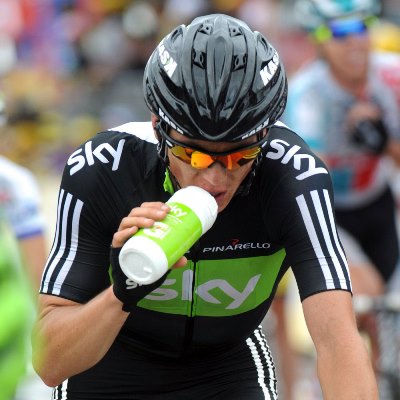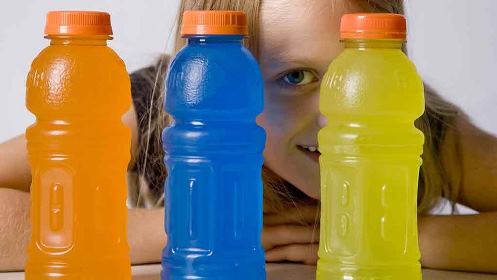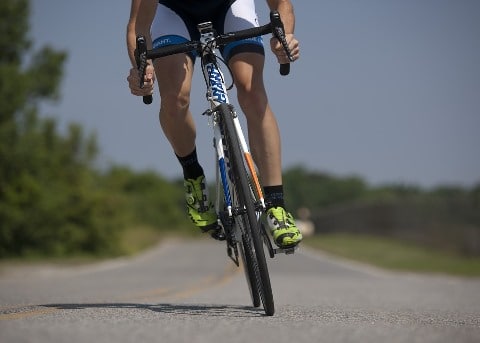- You are here:
- Home »
- Blog »
- Blog
- » What Does Isotonic Mean ?

What Does Isotonic Mean ?
Professional riders, tourists and workout enthusiasts know that cycling is kind of expensive hobby. No matter if you’ve purchased a brand new road bike with all your savings, if you’re wondering “This is it! I don’t have to spend anymore”, you need to wake up.
There are plenty of things to take care of, such as road bike shoes, bottle cages, pair of gloves, and of course, the helmet. Besides on-going maintenance cost, there is another cost that cannot be separated, and that is, “Sports Nutrition”.
While cycling for over 90 minutes, you’d have lost so much energy that a bottle of water or a lemonade wouldn’t compensate for it. You need something energetic and highly nutritious, such as isotonic drink. Riding without an isotonic drink is just like driving a car in an unknown territory without a map. There’s always a risk of car running out of gas in the middle of the journey.

Image Source: cycling-passion.com
Here’s what isotonic drink does:
- It keeps you fresh,
- Gives you an ability to ride faster, and
- Maintains your glucose level so that you don’t lose focus
What Does Isotonic Mean ?
Isotonic drink is a sports drink that contains following basic ingredients:
- Water
- Electrolytes, and
- Carbohydrates (or similar substances)
The more the carbohydrates the better will be the drink. In best isotonic drinks, carbohydrates are in high concentration, ranging between 6 to 8 percent. Organic compounds, such as sucrose, fructose and glucose have higher concentration of carbs, so they’re the basic ingredients of isotonic liquids.
The need of isotonic drink
As you cycle for long duration, your muscles lose high amount of carbohydrates, due to which you get fatigued. As a result, your ability to ride at consistent pace diminishes. Here, isotonic drinks can help you restore carbohydrates in your muscles and keep going on long rides.
Some studies have shown, cyclists improved their performance up to 20% because of isotonic drinks. Moreover, when you get carbohydrates, your mind keeps working normally, so that you can finish long rides.
How is isotonic Different from Water?

Image source: choice.com.au
New comers often ask whether they need a sports drink and whether water was enough for them. According to sports nutritionist, Wendy Martinson, it entirely depends upon the length and level of the workout session.
Water is a great liquid without any doubt, but it helps in shorter sessions. When a workout session stretches beyond 60 minutes, water won’t be sufficient. You’re going to need isotonic sports drink.
Taking this discussion further, the head of sport science in Lucozade, Nick Morgan comes up with a view that sports drink can also help in shorter workouts. According to him:
- If you had meal with containing high amount of carbohydrates just 2 – 3 hours prior to training, isotonic drink would be unnecessary.
- If you didn’t have a proper meal, or hit the gym on the way back from work, or didn’t eat anything at all, you’re going to need sports drink during the workout session. It will give you that extra energy that you’d be missing because of empty stomach.
Studies have shown that isotonic drink was responsible to improve treadmill running time among recreational runners, up to 27%.
Benefits of Isotonic Drink
Listed below are some of the best benefits you could get with isotonic sports drink. Surely, there will be more benefits, but these are the most prominent ones. The purpose is to encourage you to carry sports drinks when you head out for a long ride next time:
-
Prevents Dehydration

Image source:: johnstonhealth.org
When you’re sweating excessively, first thing you’ll do is have some water down your throat. In reality, it can cause bloating. Moreover, water doesn’t have any carbohydrates or electrolyte. So, you wouldn’t get any help in retaining body fluid and reducing urine excretion.
Here, only isotonic drinks can serve you better as they contain carbohydrates as well as electrolytes in abundance. The higher level of carbohydrates will slow down the emptying of stomach significantly. So, your body will retain the fluid and you’ll be safe from dehydration.
-
Maintains Glucose Level
When you ride a bike on hard and long terrain, your body tends to lose carbohydrates quickly. If you ride for two hours or more, the carbohydrate deposits will be exhausted. But if you drink isotonic liquids during riding, you can keep your glycogen level high so that your muscles keep functioning properly.
Your body converts glycogen in isotonic supplements into glucose, and stores it in your liver and muscles. Unlike fat or protein, glucose needs less oxygen to burn.
-
Keeps Natural Minerals in Balance

Image source: bbcgoodfood.com
Electrolytes are abundantly found in isotonic sport drinks. Actually, electrolytes are the collection of important minerals that are helpful in keeping potassium, phosphate, magnesium, sodium, chloride, sulphate, bicarbonate and calcium etc. in balance throughout the human body. These elements are the building blocks of the human body and are present in cells.
In 1998 International Sports Medicine Journal published a study of the impact of isotonic liquids on cyclists. Two groups of cyclists were given two different liquids; isotonic sports drink (in the form of caffeinated soft drink) and mineral water with low sodium. Cyclists who had drunk isotonic drinks were found to retain more magnesium, sodium and calcium in their bodies, compared to the other group.
-
Improves Will Power
When you’re on the road riding a bike, your endurance is the only weapon that pushes you further and further towards your destination. University of Edinburgh conducted several different studies to understand the impact of isotonic drinks on young riders.
Two groups of young athletes were given two different liquids; isotonic drink and placebo solution. The results revealed that those who had isotonic drinks continued high-intensity activity 24% longer as compared to those who had placebo drinks.
Who can drink them?

Image source: bikeradar.com
- Athletes; when they’re training for stamina, speed and power
- Long-distance runners; to build their stamina and give them energy
- Road bike professionals; to protect them from dehydration and keep them moving forward
How will my body utilizes them?
The body tends to utilize glucose for energy, because it’s the easiest source to get. Isotonic drinks have carbohydrates in the form of concentrated glucose. So, they help keep your glucose tanks full during long rides.
How Much Should One Drink?
Few years back American College of Sports Medicine modified its guidelines concerned with taking fluid during physical activity. Now, athletes and pro-cyclists no longer have to follow volume charts.

Image source: sport-fitness-advisor.com
There are a couple of reasons for revising the guidelines,
- Every individual has his own needs and body requirements. So, it’s quite impossible to make or follow a hard-n-fast rule for fluid intake.
- Following specific volumes per hour can alter the balance of your body. There is a high risk of dehydration as well as water intoxication.
6 Steps to determine the amount of drink for your body
According to Wendy Martinson, you have to calculate and workout your body’s sweat rate. It will help determine the how much isotonic liquid you should take. Follow these steps to find out your sweat rate.
- Step – 1: Measure your pre-training weight without clothes.
- Step – 2: Choose either 30-minute session or a 60-minute session without consuming any fluid.
- Step – 3: After training and removing all the sweat off your body, measure your nude weight again.
- Step – 4: Find out the weight loss by subtracting the weight measured in step – 3 from the one measured in step – 1.
- Step – 5: Convert the weight loss figure in grams by multiplying it with 1000. This is actually the loss of fluid from your body during the session.
- Step – 6: If you opted for 60-minute session, the figure indicates ml per hour. If you underwent a 30-minute session, multiply the number by 2 to get the figure. This is actually the amount of isotonic liquid you should consume in a session of one hour. Suppose, you lost 300 grams in a 30-minute session. That means you have to consume 600 ml of isotonic drink every hour during training sessions.
Other factors, such as intensity, temperature and weather conditions will also affect the fluid loss. So, keep these factors in mind for future sessions.
Isotonic vs Hypotonic vs Hypertonic
Isotonic drinks are categorized into three drinks, on the basis of carbohydrate concentration level. Each of these mixtures can provide different kinds of support during long rides.

Image source: holmesplace.es
So make sure, you had the right one for your next ride:
Isotonic Drinks
- Every 100 ml of isotonic drink contains 5g – 8g of carbohydrates. So the concentration level of carbohydrates is 5% – 8%.
- Isotonic drinks provide energy without affecting fluid absorption. The energy you’d get may not be sufficient for demanding rides, or those longer than 2 hours.
Hypotonic Liquid

Image source: Wikipedia.com
- They contain salt, electrolytes and glucose. They are ideal for riding in hot weather.
- Just like isotonic drinks, they also have low carbohydrate levels. So, they may supply energy but it won’t be sufficient during longer rides. You need a backup of other energy sources, such as bars, gels and snacks.
Hypertonic Liquid
- It contains the highest concentration of carbohydrates – over 10%.
- You can use hypertonic drinks a few days before the main event to maximize carbohydrates in your body. Or, you can have them after the event in order to restore the lost energy.
- Hypertonic drinks utilize body fluid to be able to digest properly. So, athletes use these drinks in conjunction with water or isotonic drinks.
Choosing the Right Drink for Cycling: What you need to know
To help you get better, sports drinks aim to provide exactly what your body needs during riding and training sessions. So, if you carry one or two bottles of the right sports drink, you don’t have to pack dozens of bars, carrying pouches and snacks as energy source.
It is noteworthy that we often choose the right drink for cycling, but we don’t get properly hydrated before long rides. Without proper hydration before long rides, you will not be able to get the maximum energy, no matter how good the drink is.
How to Prepare Homemade Isotonic Drink
We divide the recipe into two, based on workout duration.
For workouts below 2 hours: 
- Step – 1: Sugar (sucrose) is crucial for all homemade isotonic drinks. Take sugar between 30g and 70g. In warm weather, 30g sugar can do. For cold weather, consider 70g sugar for your isotonic drink. You can use sugar in either cube form or powder form. Add sugar in one cup of vanilla tea, lemon tea or green tea.
- Step – 2: Add some salt (to taste).
- Step – 3: Mix in a drinkable water, then allow the mixture to cool down for a while, in a refrigerator.
Alternatively; if you’re not a tea drinker, you can add fruit juice (50 cl) in place of tea and sugar. Other steps remain the same.
Your drink will remain effective for 24 hours, so consume it within a day.
Isotonic Drink for Pre-workout
Isotonic drink for pre-workout is slightly different from the usual one. You can reduce sugar and use fructose (simple sugar) instead of sucrose. Fructose is full of energy and nutrition, abundantly found in honey and fruits.
Your body assimilates fructose much slower compared to sucrose of glucose. Fructose reduces insulin secretion significantly, so the body will have low risk of hypoglycemia.
The downside is, fructose is consumed very slowly. In fact, sometimes body tends to tolerate it poorly which causes nausea and diarrhea. Moreover, compared to sucrose, fructose is quite expensive.
For workouts more than 2 hours:
If the workout session goes beyond 2 hours, merely drink containing simple sugar won’t be enough to satisfy the body, unless you take maltodextrins or solid food. Maltodextrins are glucose polymers, just like carbohydrates. They require longer duration to transform into glucose. Maltodextrins complement sucrose and fructose and provide extra power as you go on to extend your workout beyond 2 hours.
Here’s a quick way to prepare the drink for long workouts
- Add maltodextrins about 40g in one-liter water or drinkable liquid.
- Add sugar (sucrose) in the similar manner (30g for warm weather and 70g for cold weather). Sugar can be replaced with 50cl fruit juice.
- Add salt to taste.
- Complete with water and allow the liquid to cool down.
Consume the solution within 24 hours.
Conclusion
Those hearing the name, Isotonic Drink for the first time, must have had their knowledge pot full by now. Just a quick reminder:
- Isotonic drinks are specifically designed to replace the fluids that your body loses through sweating.
- Isotonic drinks are preferred over other liquids, because they have high concentration of carbohydrates that is supplied to your muscles during riding.
This is what we have till now. If you have more information or question, don’t hesitate to mention them in the comment section below.
About the Author Nick Soros
Hi, I'm Nick Soros. I have been an cycling enthusiast from 2006. Ezroadbike.com is my personal blog where I share my pedaling experience. No matter you are a new cyclist or skillful one, you would find useful topics in my site. Have a great cycling...
